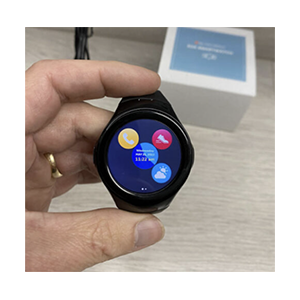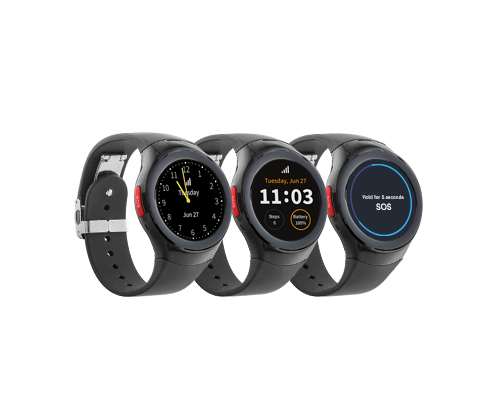MedicalAlertBuyersGuide.org is an independent review site. We may earn compensation from the providers below. Learn More

Medical alert smartwatches are revolutionizing senior safety, offering a sleek and modern alternative to traditional medical alert devices. These cutting-edge wearables combine advanced emergency response features with the convenience of a fully functional smartwatch, making them an exciting option for seniors in 2025.
How Much Does a Medical Alert Watch Cost?
Medical alert watches are more expensive than either in-home medical alerts or mobile medical alert systems. Since the watch hardware is more expensive than other medical alerts, your startup cost will be higher as well. Most companies also charge higher monthly monitoring fees for medical alert watches.
To give you a clear picture of what each system costs, we’ve calculated the First Year Total Cost of Ownership for each watch we’ve reviewed. That number includes the startup cost to get the watch, plus the first 12 months of monitoring fees, assuming you choose a monthly monitoring plan. The table below shows the costs you can expect.
| Company | System | Startup Cost* | Monitoring | Fall Detection | First Year Total Cost |
|---|---|---|---|---|---|
| Bay Alarm Medical | SOS Smartwatch | $159 | $34.95/mo | $10.00/mon | $578.40 |
| Medical Alert | Medical Alert System Review | $159 | $39.95/mo | $10.00/mon | $638.40 |
| Lifestation | Sidekick Smart | $99.95 | $47.90/mo | Free | $674.75 |
| Apple Watch | Series 9 GPS + Cellular | $499** | $14.99/mo | Free | $678.88 |
** - Apple Watch price is for Series 9 GPS + Cellular & third-party monitoring
Will a Medical Alert Watch Work with iPhone or Android?
How We Tested: Hands-On Testing + In-Depth Reviews
To choose the Best Medical Alert Smartwatch, our team performed over 100 hours of hands-on testing for the leading smartwatches.
We purchased all the medical alerts included in this review and evaluated all steps of the experience: from buying the system, to setting it up, and real-life testing, including simulating falls.
We focused on both the technical aspects of the system as well as the quality of service provided by the vendor. We evaluated all aspects of the consultation, took notes on which brands gave us a fair assessment vs those that just simply wanted to oversell, and also took notes on which brands were pushy and high-pressure. During our simulated falls, we also evaluated the interaction with emergency operators who called to check on us.
Disclosure: In order to provide this free service to our visitors, Medicalalertbuyersguide.org may receive compensation if a purchase is made through this website.
| SOS Smartwatch | |
|---|---|
| Device Cost: | $111.30 |
| Shipping Fee: | $12.00 |
| Emergency Monitoring: | $34.95/month |
| Automatic Fall Detection: | $10.00/month |
| Charge Time: | 4 hours |
| Battery Life: | Up to 24 hours |
| Service: | Excellent |
Bay Alarm Medical "SOS Smartwatch" Overview
Bay Alarm Medical has an excellent reputation when it comes to its pricing, customer service, and product reliability. Our experience with the SOS Smartwatch did not disappoint. We chose Bay Alarm Medical’s SOS Smartwatch as our pick for both Best Value Smartwatch and Best Overall Smartwatch.
The SOS Smartwatch has added automatic fall detection using an algorithm powered by artificial intelligence, a key feature missing from most medical alert watches. Using AI to reduce the risk of false alarms, we think this feature is a game changer and may make the SOS Smartwatch the best medical alert system of any type.
Bay Alarm Medical is a full-service medical alert provider. They offer home landline and cellular home medical alert systems as well as the SOS Smartwatch. The Bay Alarm Medical sales representatives were friendly, knowledgeable, and eager to help us choose the correct system for our needs. There was no hard sell and no pressure to purchase extra add-ons or upgrades.
The unboxing and set-up process couldn’t have been easier. The smartwatch arrived charged and ready to use. Even better, Bay Alarm Medical completes the product registration during check-out. The first time you push the SOS button, the operator already knows who and where you are. If you’ve ever spent a frustrating amount of time on hold waiting to “activate” a product or service, you’ll appreciate Bay Alarm’s system even more!
The smartwatch itself is easy to use and comfortable to wear. The sleek black design doesn’t look like a medical device – just a regular smartwatch. This is an important consideration because a medical alert device only works if you actually wear it. The SOS Smartwatch is a good option for someone who is reluctant to wear a medical alert pendant or clunky wristband.
During our tests, Bay Alarm Medical’s monitoring center responded within 15 seconds after we pushed the SOS button. The operators were helpful – even calling back to ensure that everything was ok.
Our testing of the watch’s automatic fall detection feature also found it to do a good job of distinguishing between false alarms and hard falls that signal an emergency.
Medical Guardian’s MG Move Smartwatch is the nearest competitor to the SOS Smartwatch. It offers additional apps and a robust Caregiver Portal that makes tracking the movements of your loved one easier. We do wish that the Bay Alarm SOS Smartwatch offered similar options. But the SOS Smartwatch now offers automatic fall detection, while the MG Move does not have this key feature.
The first-year cost difference between the SOS Smartwatch and MG Move is also substantial: $662.70 for the SOS Smartwatch compared to $811.85 for the MG Move. Medical Guardian’s monthly monitoring charges are also higher than Bay Alarm Medical’s.
We think that Bay Alarm Medical’s excellent service and affordable price structure make it a better value than the MG Move.
Read our full, hands-on review of the SOS Smartwatch.
| Device Cost: | $99.95 |
| Shipping: | $12.50 |
| Emergency Monitoring: | $46.95/month |
| Automatic Fall Detection: | Not available |
| Charge Time: | 4 hours |
| Battery Life: | Up to 24 hours |
| Service: | Good |
LifeStation Sidekick Smart Medical Alert Watch Overview
LifeStation’s newest entry into the growing medical alert smartwatch market provides a solid standalone GPS-enabled smartwatch with two-way communication, 4G LTE and wi-fi connectivity, a nicely-designed user interface, and three built-in apps: step counter, heart rate monitor, and weather. We were impressed by LifeStation’s call center response times of less than a minute – in an emergency, every second counts – and the easy two-way communication via the smartwatch and through Amazon Alexa.
However, the LifeStation Sidekick Smart comes at a higher cost with fewer options and features than its close competitors, Bay Alarm Medical and Medical Guardian.
We spoke with LifeStation representatives by phone about the system before purchasing. The representative was friendly, helpful, and patiently explained our options to ensure that we purchased the best system for our needs. There was no pressure to buy and no follow-up sales calls.
The purchase and return processes were easy and seamless.
The LifeStation Sidekick Smart display has a clean, intuitive design. The watch face is bright with large, easy-to-read fonts, even in bright light. To use, simply press the button to wake the device, then easily swipe between the apps, which open with a single tap. To call for help, press and hold the button for five seconds. Tap the screen again to cancel if you’ve accidentally triggered the alarm.
The Sidekick Smart display screen is a real standout. Most medical alert smartwatches just show day and time on the default display. But the Sidekick shows time, daily step count, and heart rate. That’s information that many people track multiple times a day, so it’s nice to see them at a glance without drilling down through menus or checking a separate app.
Activation and set-up was easy, except for one unexpected hitch: LifeStation doesn’t allow you to activate a new device on a weekend. That was a surprise!
The weekend is often the best time for someone to help a relative set up, activate, and test a new medical alert system. We strongly urge you to unbox, activate, and test the system yourself before taking it to your loved one’s home.
Other data points that keep us from giving the LifeStation Sidekick Smart our highest rating include:
- Short battery life: The watch went from a full charge to a 50% charge in about 7 hours of use. After 12 hours, the low battery warning chimed and gave us a spoken alert.
- Charging cradle: It’s possible to insert the watch the wrong way, so you think it’s charging but it isn’t. Other smartwatch chargers we tested actually pushed the watch away if you tried to seat it improperly.
- No caregiver portal or tracking app: None of LifeStation’s systems feature a caregiver portal with tracking.
Note that, like all medical alert smartwatches, the Sidekick Smart doesn’t offer fall detection as an option. If you’re looking for a mobile medical alert system for someone who has a significant fall risk, consider an on-the-go system that combines a pendant with a GPS-enabled help button.
The Sidekick Smart is a decent budget-friendly choice, with a relatively low first-year total cost. However, we feel that the Bay Alarm Medical SOS Smartwatch is a better option for cost-conscious buyers. The MG Move’s monthly monitoring fee is just $1 more than the Sidekick Smart, but offers more options and features – including a Caregiver Portal with tracking.
| WiFi Only | WiFi + Cellular | |
|---|---|---|
| Device Cost: | Starting at $399 | Starting at $499 |
| Emergency Monitoring: | None | $From $14.99/mo+ (varies by carrier) |
| Automatic Fall Detection | Free | Fee |
| Charge Time: | 4 hours | 4 hours |
| Battery Life | 18 hours | 14 hours |
| Service: | Unmonitored | Unmonitored |
Apple Watch Overview
We tested Apple’s Series 9 GPS 41mm version, as well as the Series 9 GPS + Cellular 41mm watches. Like all Apple products, they are stylish, customizable, and offer top-notch hardware, software, and service. Many users may choose an Apple Watch as a medical alert smartwatch because it doesn’t “look” like a medical device and has numerous options for the color, size, and design of the watch. In addition, many third-party sellers offer further customization like magnetic clasps.
If you’re already familiar with Apple’s products, user interfaces, and have access to an iPhone, it’s very tempting to use the Apple Watch as a medical alert device. The Apple Series 9 can also show your blood oxygen level and take an electrocardiogram (ECG). However, it’s important to understand that an Apple Watch is foremost a chic, well-designed smartwatch that can also serve as an unmonitored medical alert system.
How does it stack up against other medical alert smartwatches we tested? We have some reservations.
The Apple Watch is tethered to the Apple device ecosystem. For example:
- You need an iPhone to set up both the GPS-only or GPS + Cellular models.
- Some health apps are not available if you set up the GPS + Cellular phone as a standalone Apple device (meaning the user doesn’t own an iPhone and will use Family Sharing).
- The GPS-only version of the Apple Watch must be connected to wi-fi or be within Bluetooth range of the paired phone to make an emergency call.
- The medical alert functions on the GPS + Cellular phone will work without wi-fi or an iPhone connection, but the user must be connected via Family Sharing.
- Some cellular service providers charge extra fees when pairing an Apple Watch to an iPhone. Check with your provider about extra costs/fees.
The setup process requires an iPhone, which guides you through the process step-by-step. This is easy for someone familiar with the Apple interface – or even someone who is relatively tech-savvy. However, the process might be confusing or frustrating for anyone less experienced with technology.
For example, when you set up an Apple Watch from scratch, you’re prompted to go through the following settings and more:
- Watch passcode
- Cellular setup
- Location sharing
- Using Siri
- Analytics sharing with Apple
- iCloud messages
- Permission for the iPhone user to see the Watch user’s health data
There are additional steps to designate an emergency contact to receive notifications when the user falls or share their Medical ID information with emergency responders.
The Apple Watch is the only smartwatch we tested that includes fall detection. If you enter your age when you set up your watch or the Health app, and you’re 55 or older, fall detection is automatically activated. This is a valuable feature, since according to the CDC, one in four older adults will fall each year – making falls a public health concern.
That’s a nice feature, but unfortunately we found it to be buggy and unreliable. Most medical alert providers don’t offer fall detection with smartwatches because it isn’t dependable – yet. Research shows that wrist devices alone generally have low fall-detection accuracy and suffer from high false-positive rates. It’s common for users to trigger a false alarm if they wave their arms around and/or bump into things.
However, our tester couldn’t trigger any fall detection notification – not even when she fell for real down several steps and suffered an actual injury. If you or your loved one has a health condition or lifestyle that carries a serious risk of falls, we strongly encourage you to consider a monitored medical alert system that uses a pendant or more reliable device.
If you’re familiar with Apple devices and comfortable using an unmonitored medical alert system, we recommend the GPS + Cellular model. It’s a better choice for people who are often on-the-go because it has access to a cellular network and can be used even when out of range of an iPhone.
Consider whether the user might prefer a simpler smartwatch medical alert such as SOS Smartwatch or MG Move. Both are standalone devices specifically designed as medical alert systems. They provide easier communication in an emergency and don’t require a smartphone.

2025 Editor's Choice
We chose Bay Alarm Medical’s SOS Smartwatch as the best value because of its affordable price, excellent customer service, and top-notch response times.
With the latest version of the SOS Smartwatch adding automatic fall detection, we think it’s the best overall medical alert watch as well.
Medical Guardian’s MG Move is our second pick if money is no object. The MG Move offers an enhanced caregiver portal and optional caregiver communication and texting apps.
You can rely on our team to help you make an informed decision on the medical alert system for you or your loved one. Depending on individual needs and preferences, a smartwatch may – or may not – be the best option. For example, smartwatch fall detection systems can generate a lot of false alarms. Many people resist wearing medical alert pendants, but they are currently the most reliable ways to detect falls.
Please share this resource guide if you find the information helpful!
Key Features of a Medical Alert Watch
Besides price and reliable help in an emergency, what should you look for in a medical alert watch? We’ve broken things down to five key features you should consider when choosing a watch, along with how these features factored into our choice of the best smartwatch.
-

Standalone Medical Alert or Smartphone Accessory?
A key question about any medical alert watch is whether the watch is a standalone system or an accessory to your existing smartphone. The Apple Watch is an accessory and requires you to also have an iPhone with a cellular plan.
In comparison, the medical alert watches from Bay Alarm Medical, MedicalAlert.com and Lifestation are standalone systems that include everything you need. They operate independently, without the wearer needing a smartphone. The watch has a built-in cellular connection that is included in your monthly monitoring subscription, so you don’t need a separate cellular plan.
We like both the simplicity and the lower cost of standalone systems, and so we rewarded more points to this type of system over accessory watches such as the Apple Watch.
-

GPS Tracking for Families & Caregivers
-

Battery Life
Be aware that medical alert watches have a relatively short battery life. Typically, the watch will work for 18-24 hours on a full charge. In practice, the wearer needs to charge the watch when they go to bed each night.
All of the standalone watches we tested made charging an easy process: just place the watch in its charging cradle. Magnets ensure that the watch is properly seated for charging and the system will announce “charging” to confirm a good contact.
But if you think your loved one may forget to charge their watch, you might consider a mobile medical alert system. These systems can run for 3-5 days without recharging. See our list of the Best Mobile Medical Alert Systems.
-

Smartwatch Apps
Besides acting as a medical alert system, all medical alert watches offer a basic set of smartwatch apps. These include things like a weather app, a step counter and a heart-rate monitor.
These apps are similar to what you’d find on a fitness wearable, like a FitBit.
While apps are a nice addition, we see them as less important than the core medical alert features of the watch.
-

Automatic Fall Detection: Built-In or Optional Pendant?
One of the most surprising aspects of medical alert smartwatches is that most do not include built-in fall detection—a feature many people expect.
Among all the medical alert watches available today, only two models offer integrated fall detection: the Apple Watch Series 9 the SOS Smartwatch from Bay Alarm Medical
Why Don’t More Medical Alert Watches Have Built-In Fall Detection?
Many medical alert watches can provide automatic fall detection, but only when paired with a separate pendant worn around the neck or waist.
The reason? Fall detection sensors worn on the wrist are far more prone to false alarms due to natural arm movements while walking.
-

Frequently Asked Questions About Medical Alert Watches
Do smartwatches work with all cellphone types?
The smartwatch medical alert systems we recommend do not need to work with your smartphone. They are standalone systems. Among medical alert smartwatches, only the Apple Watch requires a phone, which is one reason it was not our pick for Best Medical Alert Watch.
How much does a smartwatch cost?
The equipment cost can range from around $150 up to $500 and above, with monthly services adding to this cost. At Medical Alert Buyer’s Guide, we don’t sell smartwatches (or any devices) ourselves, we purely test, review and recommend them. Our pick for “Best Medical Alert Smartwatch” currently is the SOS Smartwatch from Bay Alarm Medical.
What features do smartwatches have?
Dedicated medical alert smartwatches can include fall detection, 2-way voice connection, 24/7 monitoring center, GPS location tracking, useful apps such as for weather, and health and fitness features such as step-counting. They have their own SIM card and connect to the cell network without the wearer even needing to own a cell phone.




